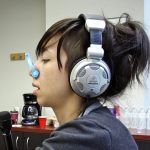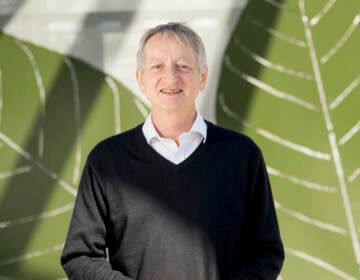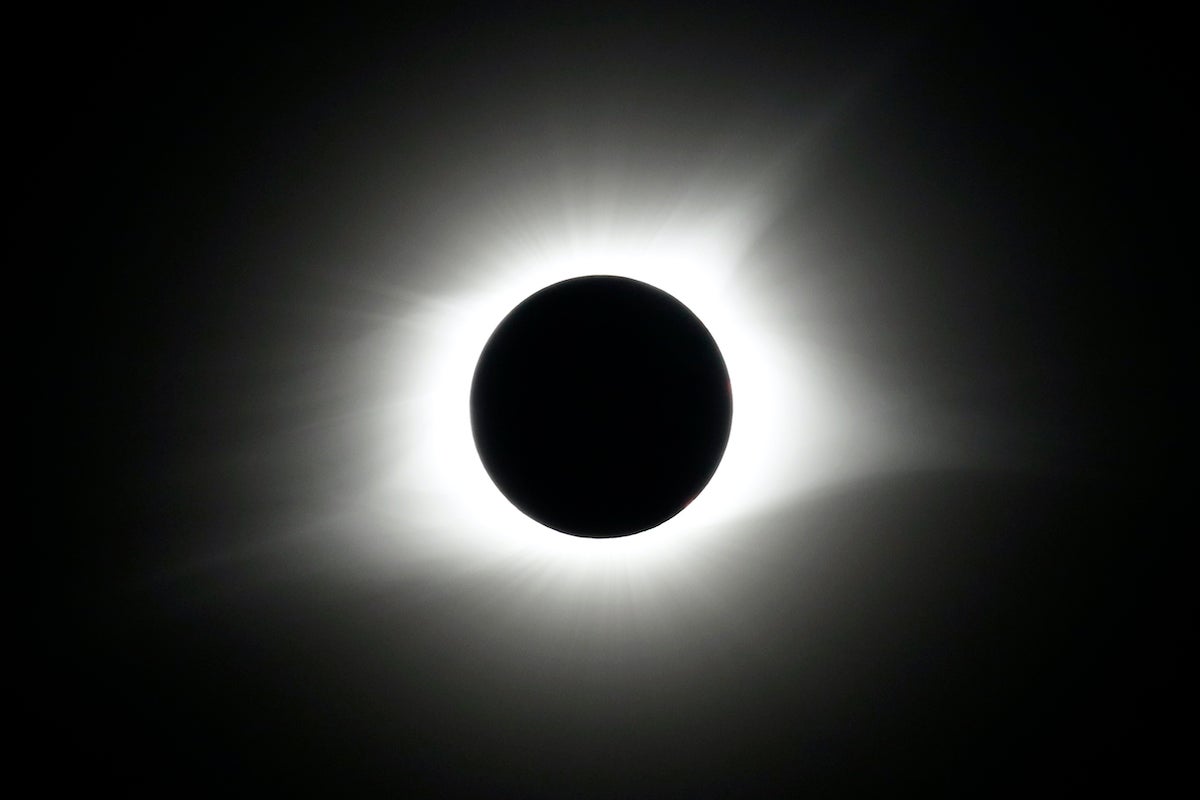Exploring the space-time-stench continuum, where no nose has gone before
Why NASA is creating — and then sniffing out — some of the foulest smells known in the universe.
Listen 10:23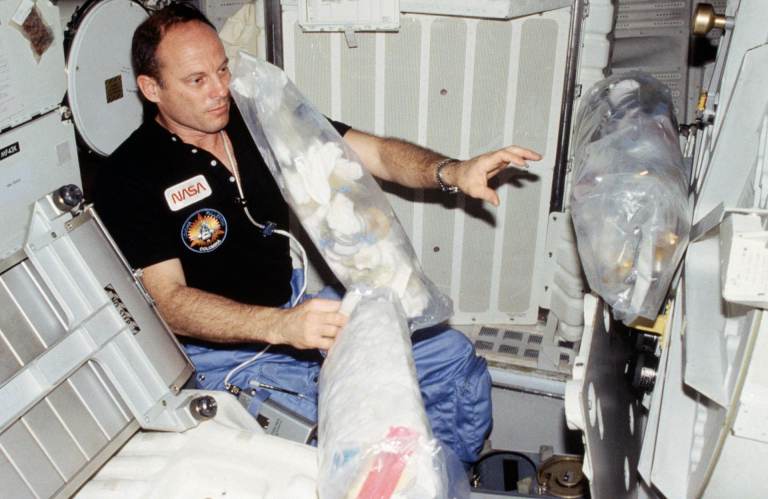
Astronaut Jack R. Lousma, STS-3 commander, wearing communication kit assembly mini headset, gathers three freefloating plastic trash bags filled with empty containers, paper towels, straws, etc. Lousma will stow them in a designated stowage volume. (NASA)
This story is from The Pulse, a weekly health and science podcast.
Subscribe on Apple Podcasts, Spotify or wherever you get your podcasts.
When NASA chemist Julio Padilla wants to vet new “sniffers” for the agency’s odor lab, he uses what’s called the “10 bottle test.”
“Three of them are blanks, which is just distilled water with no smell, and seven others have a smell to them,” he said, lining up the small bottles.
The seven scented bottles comprise a kind of menu of strong scents — from floral and minty, to pungent and putrid — all of which come labeled only with numbers.
The job of the potential sniffers is to identify the blanks — “the most important part,” Padilla said, as it determines whether or not someone qualifies as a sniffer — in addition to distinguishing between the seven other smells. If they can do that, it means their noses are perfectly calibrated for lab-level sniffing.
Padilla offered a demo.
“All right, so start with one,” he said, and took a sniff. “Smells like ether — so I would mark it down … as being the smell of etherol.”
He gave it another sniff. “Doesn’t smell too bad,” he said. “I love the smell of ether, actually.”
The next couple bottles were harder to tell. Padilla guessed that the second bottle might be floral, and that the third one was a blank.
On the fourth bottle, he took a deep whiff — and instantly recoiled.
“Ugh! I shouldn’t have done that,” he said. “So that one’s definitely putrid. Ugh. It smells like rotten eggs basically.”
As it turns out, this test is just the tip of a very stinky iceberg at the odor lab, which is part of NASA’s White Sands Test Facility in New Mexico.
The main job is to sniff out some of the most horrible smells you can imagine, to help NASA engineers figure out how to contain them.
The smell of space
You might not think there’s much to smell in space — but, according to the odor lab’s manager, Susana Tapia-Harper, space missions are known for getting pretty ripe.
“Especially space vehicles that have been in use for a long period of time, and that don’t get a lot of fresh air over that time,” she said, “there have been reports that those kind of smell like locker rooms.”
Astronaut Scott Kelly once said that the International Space Station smelled remarkably similar to a jail he once toured — featuring similar “combinations of antiseptic, garbage, and body odor.”
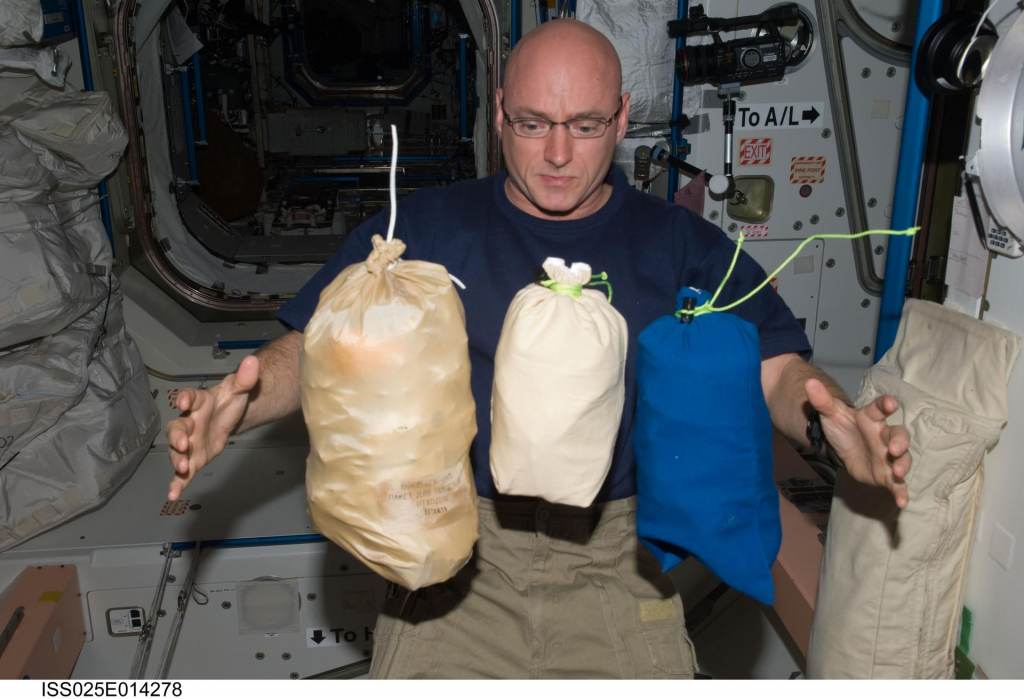
It makes sense, if you think about it. Most space missions take place in cramped quarters, which in addition to being their workplace serve as astronauts’ cafeteria, gym, and, yes, their bathroom.
“If you can imagine in space, you can’t open a window,” Tapia-Harper said. “And if there’s a stinky situation in the bathroom and it’s close quarters, so there’s not much fresh air to air things out.”
The source of some smells — like kitchen trash — can at least be tied up in a bag. But that’s not the case for all.
“There are those smells, like sweat and farts, that aren’t able to be contained,” she said, “and those do start to accumulate over time.”
Subscribe to The Pulse
Tapia-Harper said minimizing smells during space missions is important for a couple reasons.
“We really want astronauts to be able to focus on their job.” she said. “If you can imagine if you had to do your homework in a nasty bathroom, it would be hard to concentrate. So that’s the kind of situation we want to avoid for our astronauts.”
But it’s not just about astronauts’ focus or quality of life — Tapia-Harper said serious stench can be a safety issue.
“If an emergency occurs on any of our space vehicles, like a fire or an ammonia leak, we want our astronauts to be able to have a very sensitive sense of smell so they can detect it immediately and then fix that problem without delay.”
Containing smells is especially important for the next big step in space exploration: crewed long-range missions. Case in point, the Orion, which is designed to support future missions that will carry astronauts to Mars. That means managing smells not for days, or weeks, but for many months — maybe even as long as a year.
Testing the hardest-working trash bag in the universe
One solution NASA has been working on is new trash bags with a superior ability to stop stench. Tapia-Harper remembers the experience testing one trash bag that was designed for use on the Orion (and was already being tested on the International Space Station.)
As the testing indicates, trash bags on long-range space missions have to work a lot harder than your normal trash bag.
“In that test, we included things like food trash — moldy food trash — that we allowed to mold over an extended period of time. We also evaluated dirty wipes and towels, but that test also included things like pee, like fecal waste in dirty diapers, because our astronauts, in some cases, don’t have access to a bathroom and do have to wear some diapers that eventually get dirty, and also vomit. So we put all those lovely things inside of one large trash bag and let it ferment for an extended period of time and took whiffs of that over a couple of months to see how well the trash bag could contain those stinky odors.”
To make the testing conditions as authentic as possible, they got a hold of actual astronaut food and served it to their volunteers.
“We had volunteers eat the food and then help to introduce their saliva and bacteria into the food packages, and then package them in the exact way that the astronauts might,” Tapia-Harper said. “So we actually got astronaut directions on how they package their food trash to try to make it as tightly sealed as possible. And then we let that sit around for a long period of time and mold.”
Their efforts were similarly authentic when it came to collecting urine and fecal waste.
“What we did is we actually received astronaut diapers,” Tapia-Harper said. “They ship those to us, and we had volunteers wear those and help collect their morning waste so that we could introduce it into the trash bag.”
For extra scientific precision, they even weighted the diapers before use and after — “So we could quantify how much waste they had provided,” Tapia-Harper explained.
Then they sealed up the mix of trash and bodily fluids inside the specially designed garbage bags, which were in turn placed inside airtight metallic chambers designed to “catch” any smells that leaked out of the bags.
As if the ingredients alone weren’t enough for a gag-inducing smell, they added one other factor — heating the trash up.
“The reason we heat it is that we also want to replicate the temperature conditions that might be seen in actual flight,” Tapia-Harper said. “And so for previous tests, we’ve actually fluctuated the temperature over time to simulate different temperatures that the trash may see, because I think as we all know, when it’s hotter, things get stinkier. And so we want to simulate that in our actual odor test as well.”
Once the trash was nice and ripe, they would crack open the metal chambers to see how they smelled. Enter the lab’s “odor panel members” (otherwise known as “sniffers,”) who were responsible for judging the degree of stink.
To deliver the smell, Julio Padilla said they used 30 CC syringes attached to masks that fit snugly around the sniffers’ faces.
“So what we do is, we draw the atmospheric air from the container, attach the mask to the syringe, and then administer that 30 ccs directly into the face of our odor panel members,” Padilla said. “And we count down from three, that way they’re ready to breathe and smell. And then I go ahead and just use a plunger to administer the gas to their face — directly to their nose.”
The power of the human nose
At that point, it’s the sniffers’ jobs to “rate” the smell according to different categories.
“One of them is potency, and that ranges from zero to four: zero being undetectable; one, slightly detectable; two, easily detectable; three, very detectable; and four is extremely detectable. So they rate it from zero to four, and they also provide a general assessment of the odor, whether it was neutral, pleasant, irritating, or revolting.”
The sniffers are also asked to describe how the odor is affecting them.
“For example, if you smelled, let’s say the vomit,” Padilla said, “you would probably gag. So that would be one of the effects of the sniff.”
Padilla said he’d never seen sniffers who were overcome by the smell — which may be partly because the trash bags were doing their job — but Tapia-Harper remembered past tests where the sniffers weren’t so lucky.
“I know that we had a lot of people reporting that they were gagging, and that they had to have the trash can right next to them because they weren’t sure if they were going to make it to the bathroom after those smells,” she said.
It’s no wonder that Jason Hutt, the Orion spaceship’s engineering lead, recently called White Sands’ sniffers the “unsung heroes of the space program.”
Which begs a question: Considering how much NASA relies on automation to do some of its most dangerous and dirtiest work, from probes that have been sent to Jupiter, to the rovers exploring the surface of Mars, why are they subjecting actual humans to these disgusting tests? Can’t they design robots to sniff trash for them?
According to Tapia-Harper, there’s a good reason why they haven’t.
“There are e-noses that have been developed to try to help characterize smells,” she said. “[But] really, despite all the best efforts to evaluate technologically what smells are, really the human sense of smell is still far superior. We have been equipped with an incredibly sensitive detector in our nose, more sensitive than anything that we’ve been able to replicate, in our current technology this far.”
“So really, that is one of the reasons that NASA does odor testing — is because we do recognize that the human sense of smell is more sensitive than we can evaluate via our current technology.”
WHYY is your source for fact-based, in-depth journalism and information. As a nonprofit organization, we rely on financial support from readers like you. Please give today.



